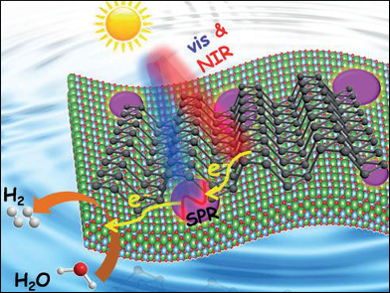One important challenge for solar energy utilization is the search for suitable materials as photocatalysts. They need to harvest broad-wavelength solar light, from UV to the near-infrared (NIR) region, but also have to achieve highly efficient solar-to-H2 conversion.
Tetsuro Majima, Osaka University, Japan, and colleagues have designed a broadband solar response photocatalyst, namely a black phosphorus (BP)-sensitized Au/La2Ti2O7 (BP-Au/LTO). The team prepared LTO nanosheets using a hydrothermal method and deposited Au nanoparticles on these sheets via a chemical reduction. Black phosphorus nanosheets were synthesized using solvent exfoliation and combined with the Au/LTO sheets by sonication.
The resulting material acts as an efficient and stable visible- and NIR-light-driven photocatalyst for H2 production. The optimum H2 production rates of the BP-Au/LTO heterostructure were around 0.74 and 0.30 mmol/gh under visible- and NIR-light (> 420 and > 780 nm) irradiation, respectively, in the presence of methanol. The results show that the use of BP with its broad absorption from UV to NIR light can improve the efficiency of plasmonic photocatalysts. This opens up new avenues for the design of efficient visible- and NIR-light-driven plasmonic photocatalysts with potential applications in solar energy conversion, according to the researchers.
- Au/La2Ti2O7 Nanostructures Sensitized with Black Phosphorous for Plasmon-Enhanced Photocatalytic Hydrogen Production in Visible and Near-Infrared Light,
Mingshan Zhu, Xiaoyan Cai, Mamoru Fujitsuka, Junying Zhang, Tetsuro Majima,
Angew. Chem. Int. Ed. 2017.
DOI: 10.1002/anie.201612315


